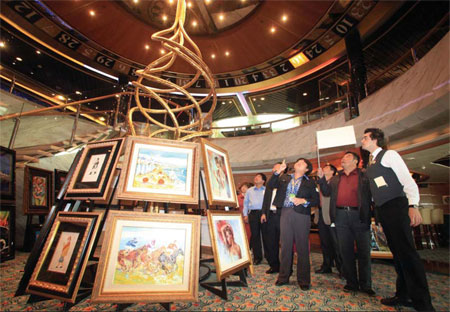Young feet ready for rough ride
Updated: 2011-10-21 11:27
By Lin Jing and Li Xiang (China Daily European Weekly)
|
|||||||||
Chinese companies, novices in the cruise industry, are lapping up the challenge
As the infant cruise tourism industry in China struggles to find its feet, companies and government are working to reduce its growing pains.
This month a business group was set up in China aimed at tapping into the cruise ship market.
The International Cruise Procurement Alliance, set up in Tianjin Binhai New Area, 170 kilometers southeast of Beijing, comprises 30 Chinese companies dealing in, among other things, food, beverages and hotel supplies. It hopes to help domestic suppliers get a slice of the business that international cruise ships offer.
|
 A business group in Tianjin on the Sun Princess, a cruise ship run by British company Princess Cruises. [Wang Huan / for China Daily]
|
"This is the first time there has been a platform for the trade in cruise consumption goods," says Zheng Weihang, secretary-general of China Cruise and Yacht Industry Association.
Zheng says that at present all the supplies to international cruise ships calling at Chinese ports are bought from foreign companies such as Wal-Mart, which results in higher costs because of complicated logistics and delays.
The alliance will invite cruise purchasing managers to trade meetings and try to win orders for domestic suppliers so as to reduce unnecessary transport costs.
Provinces in coastal areas have started to build their own international home ports and cruise ships.
Last month the government of Xiamen, in Fujian province, entered into a partnership with Royal Caribbean and China World Cruises, a subsidiary of the property and theme park developer Shan-Hai-Shu of Beijing. Royal Caribbean has been commissioned to design a 100,000-ton cruise ship to be built by Xiamen Shipbuilding Industry Co.
Working with the Xiamen municipal government, the partners plan to invest about 570 million euros in the coastal area to develop a cruise port with an amusement park and luxury hotels.
Xiamen International Cruise Co, the first Chinese cruise operator, was established in June. It will start cruises between Shanghai and Xiamen next year.
Zheng says that some entrepreneurs in Wenzhou, Zhejiang province, have raised 10 billion yuan (1.1 billion euros) and bought an Asian cruise ship. The ship is being fitted out in Singapore and will go into service by the end of the year.
Last month the island province of Hainan stepped up its efforts to promote the cruise industry, adding 60 voyages with Sanya as a home port to Southeast Asia and coastal areas on the mainland. The aim is for Sanya to evolve from being merely a port of call.
The central government is doing its bit to stimulate the cruise business.
In 2009 the State Council, in a paper on developing tourism, said the manufacture of outdoor equipment such as recreation vehicles, cruisers and yachts would be encouraged. Areas suitable for cruise yacht tourism will attract local government support.
In February the China National Tourism Administration outlined policies on tourist services related to international cruise ports and started putting them into effect on June 1.
"We will put more emphasis on overseeing the implementation of the standards so that service quality is ensured," says Wu Wenxue, director of the planning, development and finance department of China National Tourism Administration.
During the 12th Five-Year Plan (2011-2015), the Ministry of Transport will pay particular attention to managing the way ports are built.
"Relying on the experience of cruise management and port construction in developed countries, we have formulated industrial standards on safety, usability and operations," says Song Dexing, director-general of the water transport department of the Ministry of Transport.
Nevertheless, there are concerns about the many hurdles to be overcome in building a fully fledged cruise industry in China.
A cruise industry chain consists of ship building, the cruises themselves, port services and tourism and commercial businesses down the line, and China is particularly deficient in three of these, Zheng says: shipbuilding, operations and tourism.
"There is a 30-year gap between China and the West in cruise ship design and building."
He says that at the moment the most pressing problem is a lack of professional talent. "China greatly lacks qualified talent in cruise building and operation. It is no exaggeration to say there is a complete void."
The president of Tianjin Maritime College, Ma Kuijun, says that since China's cruise industry is still in is infancy, those working in it are novices.
"They have insufficient professional knowledge in management and shipping, language and computers, and this is hindering development of the local cruise industry."
Zheng suggests that local companies work closely with foreign cruise operators and learn from their experience and technology.
"China could start building a cruise ship maintenance center. In that way, foreign companies could cut costs in China and we could pick up ideas on design and technology in the process."
Based on the China National Tourism Administration's prediction, by 2015 total tourism annual income will reach 2,500 billion yuan, with average annual growth of 10 percent. The number of outbound passengers may exceed 88 million, a 9 percent increase year on year; foreign inbound visits will be 32 million, up by 4.5 percent a year.
Wu of the China National Tourism Administration says a national tourism and leisure program will be drafted and issued during the period of the 12th Five-Year Plan, in an effort to enhance public awareness of tourism and tap the consumer potential.
"As the number of home ports and the government advocacy for outbound cruise tourism continue to rise, I believe more Chinese will switch from group travel to international cruise ships, especially in the Asia-Pacific region."









